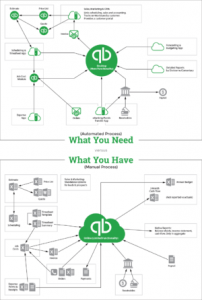“Manual processes are inefficient and prone to error.”
This is a given – it appears word-for-word in virtually any book on efficiency or controls you care to mention – but the real question is “what does this mean for you”?
Should you always automate? The answer is a qualified yes – think about the costs and benefits, and then use your judgement: you wouldn’t automate if:
- The solution is too expensive in absolute terms, or
- It costs more than the benefit it will produce, or
- The implementation is large and risky enough that it could go wrong.
If you’re an optometrist, where all your business is done face-to-face, and you have only four or five sales in an eight-hour day, then it may well makes sense to keep using that manual receipt book that you can buy at Staples for $5. (This is a real-life example).
If a lot more people come through your door for glasses, then yes, you may have to ditch the manual receipt book and invest in an e-commerce solution that automatically generates PDFs of your invoices.
Profit Breakthrough:
Ask yourself if your existing systems are holding you back. Are you using a receipt book because your volumes are low, or are your volumes low because you record your sales on a manual receipt book?
The Cloud has put a lot of user-friendly, simple, computerised automation within easy financial reach of most businesses. Existing programs have a good deal of “grunt” that comes standard at a reasonable prices – or you can pay more to get closer to Sharapova/ Williams levels.
Profit Breakthrough:
Pick the apps that “talk” automatically and easily to your GL package. That’s not just the ease of upload – that’s making sure that your timesheet system collects the 20-odd labour categories in your GL package.
When you look at your existing processes, you’ll probably find that there’s an app for that. That said, just because you can automate a process doesn’t mean you should. Always keep one eye on the cost-benefit.

